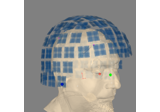mne.scale_mri#
- mne.scale_mri(subject_from, subject_to, scale, overwrite=False, subjects_dir=None, skip_fiducials=False, labels=True, annot=False, *, on_defects='raise', mri_fiducials=None, verbose=None)[source]#
Create a scaled copy of an MRI subject.
- Parameters:
- subject_from
str Name of the subject providing the MRI.
- subject_to
str New subject name for which to save the scaled MRI.
- scale
float| array_like, shape = (3,) The scaling factor (one or 3 parameters).
- overwritebool
If an MRI already exists for subject_to, overwrite it.
- subjects_dir
None| path-like Override the
SUBJECTS_DIRenvironment variable.- skip_fiducialsbool
Do not scale the MRI fiducials. If False (default), an OSError will be raised if no fiducials file can be found.
- labelsbool
Also scale all labels (default True).
- annotbool
Copy
*.annotfiles to the new location (default False).- on_defects‘raise’ | ‘warn’ | ‘ignore’
What to do if the surface is found to have topological defects. Can be
'raise'(default) to raise an error,'warn'to emit a warning, or'ignore'to ignore when one or more defects are found. Note that a lot of computations in MNE-Python assume the surfaces to be topologically correct, topological defects may still make other computations (e.g.,mne.make_bem_modelandmne.make_bem_solution) fail irrespective of this parameter.New in v1.0.
- mri_fiducials
None|listofdict If provided, these fiducials will be used as the originals to scale instead of reading from
{subject_from}/bem/{subject_from}-fiducials.fif. This is useful typically when usingmne coregor similar and you have modified the MRI fiducials interactively, but have not saved them to disk.New in v1.12.
- verbosebool |
str|int|None Control verbosity of the logging output. If
None, use the default verbosity level. See the logging documentation andmne.verbose()for details. Should only be passed as a keyword argument.
- subject_from
See also
scale_bemAdd a scaled BEM to a scaled MRI.
scale_labelsAdd labels to a scaled MRI.
scale_source_spaceAdd a source space to a scaled MRI.
Notes
This function will automatically call
scale_bem(),scale_labels(), andscale_source_space()based on expected filename patterns in the subject directory.
